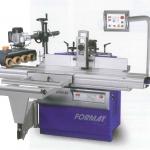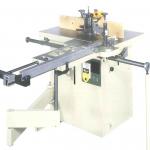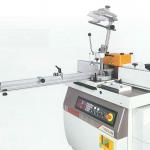Slide tableIn order to ease the workpiece guidance on spindle moulders it is possible to equip machine tables with various sliding tables, depending on the main application. Table-integratedThe machine table is divided up into fixed and mobile halves. The fixed half reaches from the rear table edge to the front, somewhat past the router head. It bears the guide for the mobile table half on its front edge. The mobile table half is generally as long as the fixed half. The manufacturer Format 4 configures this roller table similarly to the trimming table of a sliding table saw and offers a wide cross table as a special accessory. This enables the assured edge moulding of larger workpieces. Purpose:
Advantages:
Disadvantage:
Sidewise roller tableA single or double round or flat steel guide is fitted on the left side of the spindle moulder, on which the cast-iron tenoning table can be driven backwards and forwards. In the normal position, this tenoning table mounts flush to the machine table. However, it can be raised above the table level and applied to the router head. This position is suitable for the tenoning of heavier workpieces. When not in use it can be driven right back. For lengthwise processing it is only necessary to rotate the milling stop unit 90° forwards. A machine equipped with a glazing bead saw aggregate can be used as a small window processing centre. Purpose:
Advantages:
Front roller tableA round bar guide is mounted on the front edge of the machine table, on which it is possible to drive a small cast-iron cross table from right to left. This cross table is supported at the bottom by a two-part tilting arm. It is possible to fasten a clamping device and stop ruler on the cross table. Purpose:
Advantages:
Tenoning deviceThis device, intended for the tenoning of lighter workpieces, comprises a double guide and a small, light cast-iron table with clamping device and stop ruler. It is mounted on the machine table in front of the router head if required. Advantages:
Disadvantages:
|
CNC machining centres, robots896
Edgebanding, edge processing624
Saws, cutting machines437
Planers, 4-sided moulders186
Routers, shapers, tenoners, profilers180
Drilling, mortising machines134
Presses, clamps, joining machines202
Sanding machines321
Mechanisation, storage, packing technology198
Surface coating151
Production lines125
Heating, drying, waste chopping63
Dust extraction, compressed air, vacuum140
Assembly, worktables15
Lathes29
Tools, sharpening technology91
Equipment, Other machines131





